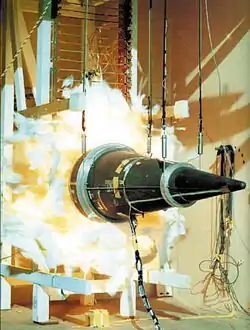Stockpile stewardship
Stockpile stewardship refers to the United States program of reliability testing and maintenance of its nuclear weapons without the use of nuclear testing.

Because no new nuclear weapons have been developed by the United States since 1992,[1] even its youngest weapons are at least 30 years old (as of 2023). Aging weapons can fail or act unpredictably in a number of ways: the high explosives that compress their fissile material can chemically degrade, their electronic components can suffer from decay, their radioactive plutonium/uranium cores are potentially unreliable, and the isotopes used by thermonuclear weapons may be chemically unstable as well.[2]
Since the United States has also not tested nuclear weapons since 1992,[3] this leaves the task of its stockpile maintenance resting on the use of simulations (using non-nuclear explosives tests and supercomputers, among other methods) and applications of scientific knowledge about physics and chemistry to the specific problems of weapons aging (the latter method is what is meant when various agencies refer to their work as "science-based"). It also involves the manufacture of additional plutonium "pits" to replace ones of unknown quality, and finding other methods to increase the lifespan of existing warheads and maintain a credible nuclear deterrent.
Most work for stockpile stewardship is undertaken at United States Department of Energy national laboratories, mostly at Los Alamos National Laboratory, Sandia National Laboratories, Lawrence Livermore National Laboratory, the Nevada Test Site, and Department of Energy productions facilities, which employ around 27,500 personnel and cost billions of dollars per year to operate.
Stockpile Stewardship and Management Program
The Stockpile Stewardship and Management Program is a United States Department of Energy program to ensure that the nuclear capabilities of the United States are not eroded as nuclear weapons age. It costs more than $4 billion annually[4] to test nuclear weapons and build advanced science facilities, such as the National Ignition Facility (NIF). Such facilities have been deemed necessary under the program since President Bill Clinton signed the Comprehensive Test Ban Treaty (CTBT) in 1996,[4][5] The US Senate never ratified the CTBT. President Obama initiated a broad effort to modernize U.S. nuclear forces, which the Congressional Budget Office estimates will require approximately $494 billion to complete.[6]
Facilities
The stockpile stewardship program is supported by the following experimental facilities:[7]
- Dual-Axis Radiographic Hydrodynamic Test Facility, Los Alamos National Laboratory
- Contained Firing Facility, Lawrence Livermore National Laboratory
- National Ignition Facility, Lawrence Livermore National Laboratory
- Z machine, Sandia National Laboratories
- Omega, Laboratory for Laser Energetics
- High Explosive Application Facility, Lawrence Livermore National Laboratory
- Joint Actinide Shock Physics Experimental Research, Nevada National Security Site
- Large Bore Powder Gun, Nevada National Security Site
- Los Alamos Neutron Science Center, Los Alamos National Laboratory
- Proton Radiography, Los Alamos National Laboratory
- Big Explosives Experimental Facility, Nevada National Security Site
- TA-55, Los Alamos National Laboratory
- U1a Facility, Nevada National Security Site
The data produced by the experiments carried out in these facilities is used in combination with the Advanced Simulation and Computing Program.[7]
See also
References
- "About the Global Governance Monitor". Council on Foreign Relations. Archived from the original on 2010-03-21. Retrieved 2021-08-15.
- "Stockpile Stewardship and Management - United States Nuclear Forces". GlobalSecurity.org. April 28, 2005. Retrieved 2009-10-24.
- Kyl, John (October 21, 2009). "Why We Need to Test Nuclear Weapons". Wall Street Journal.
Moreover, unlike other nations, the U.S. has not conducted a nuclear-weapons test since 1992; it has not designed a new warhead since the 1980s or built one since the 1990s. It has reduced its nuclear-weapons stockpile by 75% since the end of the Cold War and 90% since the height of the Cold War.
- Masco, Joseph (2006). The nuclear borderlands: the Manhattan Project in post-Cold War New Mexico (paperback ed.). Princeton University Press. p. 78. ISBN 978-0-691-12077-5.
- Mitchell, Alison (September 25, 1996). "Clinton, at U.N., Signs Treaty Banning All Nuclear Testing". New York Times. Retrieved 2009-10-24.
President Clinton signed a treaty today that would ban all nuclear weapons testing and called on world leaders to take further steps to limit weapons of mass destruction.
- "Projected Costs of U.S. Nuclear Forces, 2019 to 2028 | Congressional Budget Office".
- National Nuclear Security Administration, November 2011 Quarterly SSP Experiment Summary Archived 2013-03-07 at the Wayback Machine
External links
- "2007 DOE Stockpile Stewardship Report" (PDF). Federation of American Scientists.
- Collina, Tom Zamora (March 19, 2002). "The Impact of Emerging Technologies: The National Ignition Facility: Buyer Beware". Technology Review. Archived from the original on 2006-01-16. Retrieved 2009-10-24.
- The Stockpile Stewardship and Management Program (DOE document, May 1995)
- "Remanufacturing of nuclear-weapon components within the DOE's Stockpile Stewardship Program" (PDF). Federation of American Scientists.